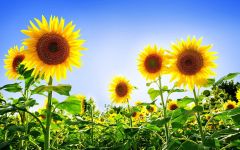![]()
![]()
![]()
Use LEFT and RIGHT arrow keys to navigate between flashcards;
Use UP and DOWN arrow keys to flip the card;
H to show hint;
A reads text to speech;
37 Cards in this Set
- Front
- Back
- 3rd side (hint)
|
Heterotrophs
|
Organism that obtains energy from the food it consumes
|
Called a consumer
|
|
|
Autotrophs
|
Organism that can capture energy from sunlight or chemicals and use it to produce food for other organisms
|
Called a producer
|
|
|
Photoautotrophs
|
Organism that makes its own food from the sun
|

PLANTS
|
|
|
Chemoautotrophs
|
Obtains energy from the oxidation of reduced molecules and uses carbon dioxide as it's carbon source
|
Example: nitrogen-fixing bacteria
|
|
|
Cell respiration
|
Chemical reactions that release the free energy of organic compounds
|
Carried out by autotrophs and heterotrophs
|
|
|
Producers
|
Autotrophs
|
Examples: Forest or an ocean
|
|
|
Consumers
|
Heterotrophs
|
Examples: Trees, seaweed
|
|
|
Decomposers
|
Heterotrophs that break down dead things for food
|
Examples: bacteria, fungi
|
|
|
Food Web
|
Made up by producers, consumers and decomposers
|
|
|
|
Abiotic
|
Non living factors that are depended upon by organisms in a food web
|
Examples: soil, water, minerals, weather
|
|
|
Biotic
|
Living factors of a food web
|
Animals, bacteria, living things
|
|
|
Ecosystem
|
Made up by the abiotic and biotic components of a particular place
|
Examples: forest, pond, prairie
|
|
|
Habitats
|
Places where particular organisms live
|
Many habitats within an ecosystem
|
|
|
Biosphere
|
All ecosystems combined make up Earth's BIOSPHERE
|
Contains many ecosystems such as coral reefs, deserts, marshes, and forests
|
|
|
First Law of Thermodynamics
|
Energy cannot be created or destroyed but it can change form
|
Also called the Law of Conservation of energy
|
|
|
Second Law of Thermodynamics
|
Systems tend to change in a way that increases the disorder of the system plus its surroundings
|
Increases the entropy
|
|
|
Entropy
|
Disorder or unorganized
|
Free energy released causes disorder
|
|
|
Enzymes
|
Specialized proteins that lower the activation energy required to make a reaction proceed
|
All living cells contain these
|
|
|
Catalysts
|
Chemicals that lower activation energy
|
In living organisms
|
|
|
Active site
|
Specific reaction catalyzed by an enzyme depends on this small area of the tertiary structure
|
Has a shape that closely matches the shape of the starting molecule(s)
|
|
|
Substrate
|
The close fit of the starting molecule
|
Joins with an enzyme at the active site
Can be bonded or unbounded by an enzyme |
|
|
Metabolism
|
Consists of all the chemical activities and changes that take place in a cell or an organism
|
Two types: synthesis & decomposition
|
|
|
Synthesis
|
"Building up" reaction
|
Type of metabolism
|
|
|
Decomposition
|
"Breaking down" reaction
|
Type of metabolism
|
|
|
Biosynthesis
|
Reactions that form larger & more complex bio molecules from small less complex ones
|
Examples: formation of starch from glucose & DNA from nucleotides
|
|
|
Oxidation
|
Process of decomposition which is the removal of e- from a molecule
|
Decomposition releasing free energy
|
|
|
ATP
|
Adenosine triphosphate
|
Free energy released from decomposition that follows a series of e- transfers and ultimately ends up in a molecule
|
|
|
Digestion
|
Processes that break down food
|
Done by the stomach to get energy from food
|
|
|
Pepsin
|
Active protein digesting enzyme in the stomach
|
Secreted by stomach gland cells
|
|
|
Small intestines
|
Major function: digestion & absorption and regulation of pancreatic secretions
|
Produces glucose, amino acids, fatty acids, and glycerol
|
|
|
Salivary amylase
|
Start of carbohydrate digestion in the mouth
|
Action of an enzyme
|
|
|
Lipase
|
Fat digesting enzyme
|
Secreted in the pancreatic and intestinal juices, splits fats into fatty acids and glycerol
|
|
|
Villi
|
Small finger-like projections
|
Increase the intestinal lining
|
|
|
Energy
|
The capacity to do work or to cause change
|
Chemical, free, heat
|
|
|
Chemical Energy
|
Creates organic molecules which create organisms
|
Organisms use this energy in chemical reactions when some is released
|
|
|
Free Energy
|
Portion of chemical energy that is available to do work
|
Examples: energy used for exercise and thinking
|
|
|
Heat energy
|
Transferred by particles crashing into each other
|
The suns rays
|

